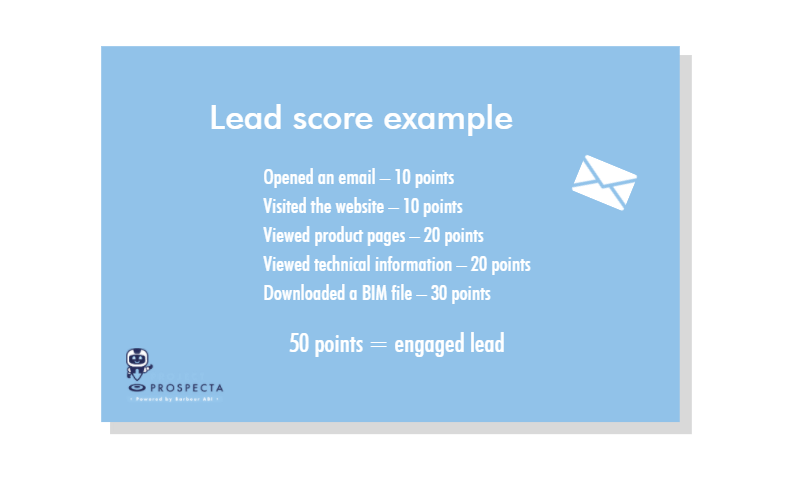Does your sales team have time to find new business? If your team is like the ones I speak to, they’re busy. And finding new business takes work. Research indicates that it takes 100 phone calls to find 1-3 leads. That’s a lot of phone calls when you have a long list of other things to do.
As a result, the focus of the sales team can switch from finding new business to managing existing business. This isn’t a great growth plan. It’s incremental and may end up moving backwards.
How can you enable your sales teams to find new business in a consistent way, without creating a large amount of work for them?
Marketing automation can fill that gap. With marketing automation, you can sort through hundreds or even thousands of prospects to find the needle in a haystack. Then hand them off to your sales team.
And let’s take it one step further. Say you hook up marketing automation to the most detailed project information available on the market – Barbour ABI. This opens up a whole world of new opportunities.
It takes a little bit of work to set up at the beginning, but it’s well worth the investment.
Here are 5 ways marketing automation can help your sales team:
Find the most relevant contacts
To find the most relevant prospect without marketing automation you have to either call or send a mass email.
But this doesn’t do the job well. You have to make hundreds of calls to find a few engaged leads. Or your generic email lands in their inbox and you never hear back.
With marketing automation, you can warm up the leads with a sequence of emails. Then you have insight into who is engaging with these emails. The contacts who are most engaged can be sent to your sales team. This means they can do outbound prospecting with a list of pre-qualified “engaged” leads.
This removes the non-relevant contacts and allows contacts to self-select into the “engaged” category.
Follow up consistently
Nothing is harder for humans than to be consistent. To be robotic. So why try? Why not leave the mundane tasks to the machines?
The first thing to automate is follow-up. If someone has opened an email and visited your website, they may not be ready to place an order, but it would be a good idea to follow up with them. With marketing automation, you can make sure that everyone who has shown interest continues to receive relevant information and personalised correspondence.
Also, if a new project is uploaded to a construction project database, like Barbour ABI, it’s a good idea to reach out to the contacts associated with it. But who has time to do this every time?
With marketing automation, you can make sure you are reaching the right contacts working on the right types of jobs as soon as they’re uploaded to Barbour ABI.
Get Valuable Insight
Most marketing automation platforms provide tracking capabilities. With this, you have access to a tremendous amount of information about what a particular lead has been looking at on your website (this is under the condition that they have opted-in). This includes: how many emails they’ve opened, links they’ve clicked, and webpages they’ve visited.
This is important because then you know who has been looking at high-value pages. These are pages like product pages, technical information, BIM files, or order forms. If a contact has been looking at this type of information it’s worth a phone call.
This way you’re not guessing at who is interested. You know who’s interested, and what they’re interested in.
Prioritise the Right Leads
Lead scores can be assigned to leads based on how they’ve interacted with your marketing campaign and their activity on your website. It tells you how engaged they are on a numerical scale (like from 0 – 50). Contacts with high scores are sent to your sales team for personal follow-up.
This is a consistent way to make sure the best leads don’t slip through the cracks, without having to call every single lead.
An example of lead scoring criteria could look like this:

This gives you a thoughtful approach to qualifying leads, to make sure your sales team is happy with the leads coming through.
Real-Time Notifications
Research shows that you have a 400x better chance of converting a lead if you make contact within 10 minutes of them showing interest in your product or service. This means you should call within 10 minutes of them looking at your website, or downloading a file, or watching your video.
The key to this is real-time notifications. Notifications that are sent to your sales team as soon as a lead shows significant interest.
Say someone in the North West downloads your brochure. Then, an email is pinged off to your salesperson covering that area. In the email are the contact’s phone number and email address and also their project information. Upon receiving the notification, the salesperson immediately picks up the phone and asks if the lead is looking for more information or a specific solution.
This type of instant insight creates real-time opportunities. Not the long-term brand-building type of opportunities usually associated with marketing.
Conclusion
Sales teams need to be finding new business, but this is increasingly more difficult. Marketing automation gives them an edge. With marketing automation, you can warm up prospects and then pass them off. This makes the outbound experience better for them, and your leads, because the conversation has already been started.
The sophistication of your marketing automation is only dependant on who you have implementing it. There is infinite potential to build out personalised journeys, interesting experiences, and lead scoring systems. All with the goal of helping your sales team find great leads.
Does this sound like a lot of work? It does take a bit to implement. But if you have help from an experienced marketing automation specialist it can take as little as an hour.
However, each business is different. If you’d like to learn more book a consultation with Jack below.



